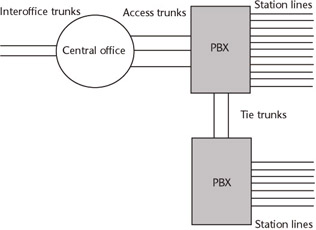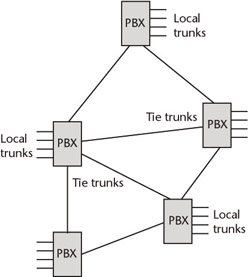7.4 Centralized Versus Distributed Systems
|
| < Day Day Up > |
|
The most common PBX network involves a centralized switching system to which all stations are connected (see Figure 7.4). Telephones, terminals, and other PBXs are connected to the PBX in a star arrangement. A central point of control simplifies implementation of the numbering plan, as well as the allocation and utilization of network resources. Overall system administration for implementing moves, adds, and changes are also simplified under the centralized system.

Figure 7.4: Centralized system architecture with two local PBXs.
The central system approach is not without its flaws, however. If the system fails, many users can become stranded without communication because there is no alternative means of routing calls.
Under the distributed approach, which became popular in the early 1980s, a number of smaller sites are integrated into a larger network and share control (see Figure 7.5). These nodes may be interconnected with each other via individual tie trunks (analog) or T1 lines (digital), which carry traffic from multiplexed tie trunks. The key aspects of this architecture are its distributed control and feature transparency. Each node functions independently and contains routing information for all other nodes. Special link protocols send information about the caller through the network to the receiving end, which lets each node on the network handle the call appropriately, based on such information as type of originating equipment and class of service. Thus, in the distributed architecture, information on network activity is relayed to each node on a continual basis, which results in a lot of management and maintenance overhead. Fortunately, an advantage of the distributed architecture is its ability to share a large number of connection channels between nodes via high-capacity links.

Figure 7.5: Distributed system architecture with multiple PBXs over a wide area.
In the distributed operating environment, trunk connections to the local CO may originate from any part of the network. With critical resources evenly distributed, the network is better protected from the possibility of catastrophic failure. But an apparent liability of the distributed system architecture is that the software needed for operational control is quite costly and complex, requiring some degree of customizing, testing, and debugging. This can become a heavy management burden to bear, if only because software problems generally are much harder to fix than hardware problems.
On the positive side, in the distributed approach, hardware problems are easier to isolate and fix. Diagnostic tools now available with most PBXs can facilitate fault isolation, regardless of architecture. Repairs or component replacements can even be performed faster under the centralized approach because the technician is already on site, whereas under the distributed approach, downtime may be prolonged until the technician’s arrival.
The argument that the distributed architecture provides a high degree of protection-against catastrophic failure is quite strong. However, even PBXs with a centralized-architecture may be adequately protected against the possibility of catastrophic failure. Redundant power and subsystems are available. PBXs offer redundant common equipment, processors, and memory. On top of that, today’s systems continually run self-diagnostics of the CPU, memory, and power units, making the system essentially fault-tolerant. For additional protection, even access lines can be brought to the PBX from different COs via dual entry points to the building, circumventing the effects of line cuts from construction equipment or a catastrophic failure at a CO.
A compromise between centralized and distributed architectures is a system that is distributed under centrally weighted control. Under the centrally weighted networking scheme, low-level functions like call setup are handled by PBXs at each node. Administrative functions like moves, adds, and changes are handled locally, whereas management and supervision of the entire network is accomplished through a designated node. From the management node, billing and traffic information can be collected from the subordinate nodes through a polling arrangement, lines and trunks may be added or reconfigured, and gateways to other networks may be accessed, such as the IP nets for voice or data.
The centrally weighted architecture is also implemented on the backbones of private networks via T1 networking multiplexers. A master node supervises the entire network. Should a subordinate node fail, the master node initiates a procedure that redistributes traffic across the entire network. When the failed node returns to operation, the master node initiates a procedure that restores the original configuration. Should the master node be disabled, network control responsibilities are handed off to a designated subordinate node. All other nodes are notified of the hand-off. When the master node is restored, the temporary master node returns control to the primary master node and resumes its status as a subordinate node.
In summary, the distributed architecture under centrally weighted control combines the advantages of centralized and distributed architectures to offer easier administration and network control, as well as a high degree of network reliability.
|
| < Day Day Up > |
|
EAN: 2147483647
Pages: 184